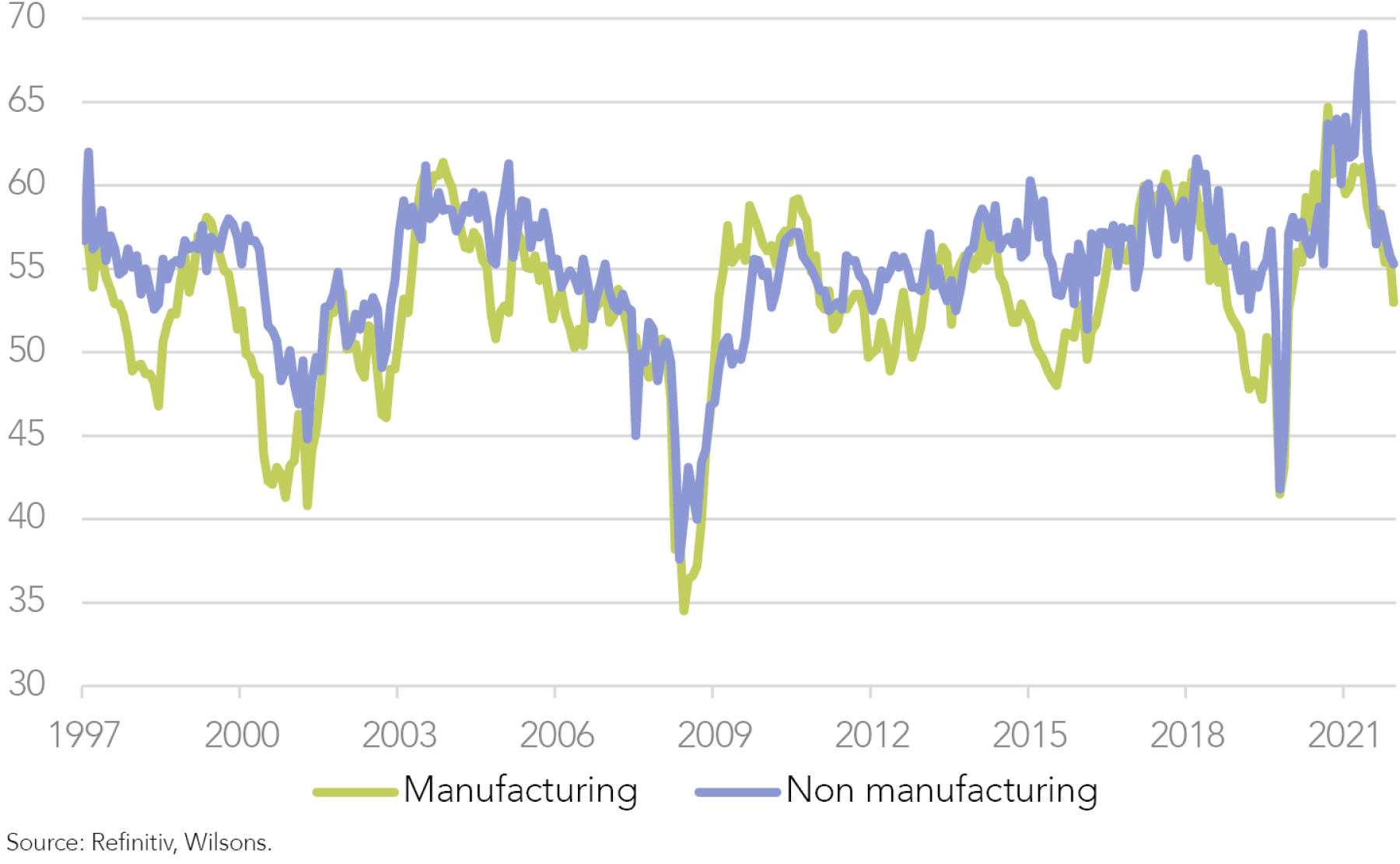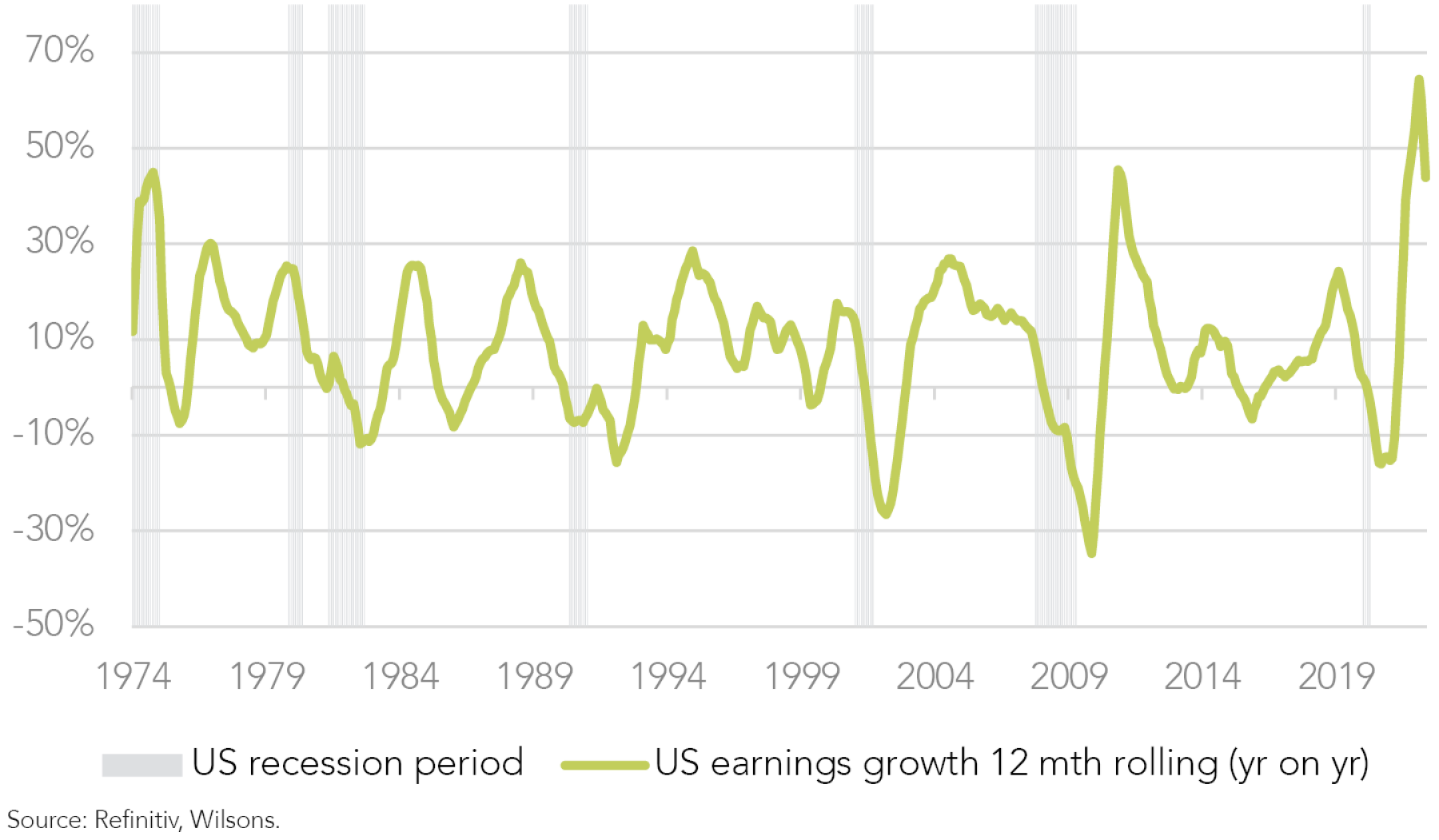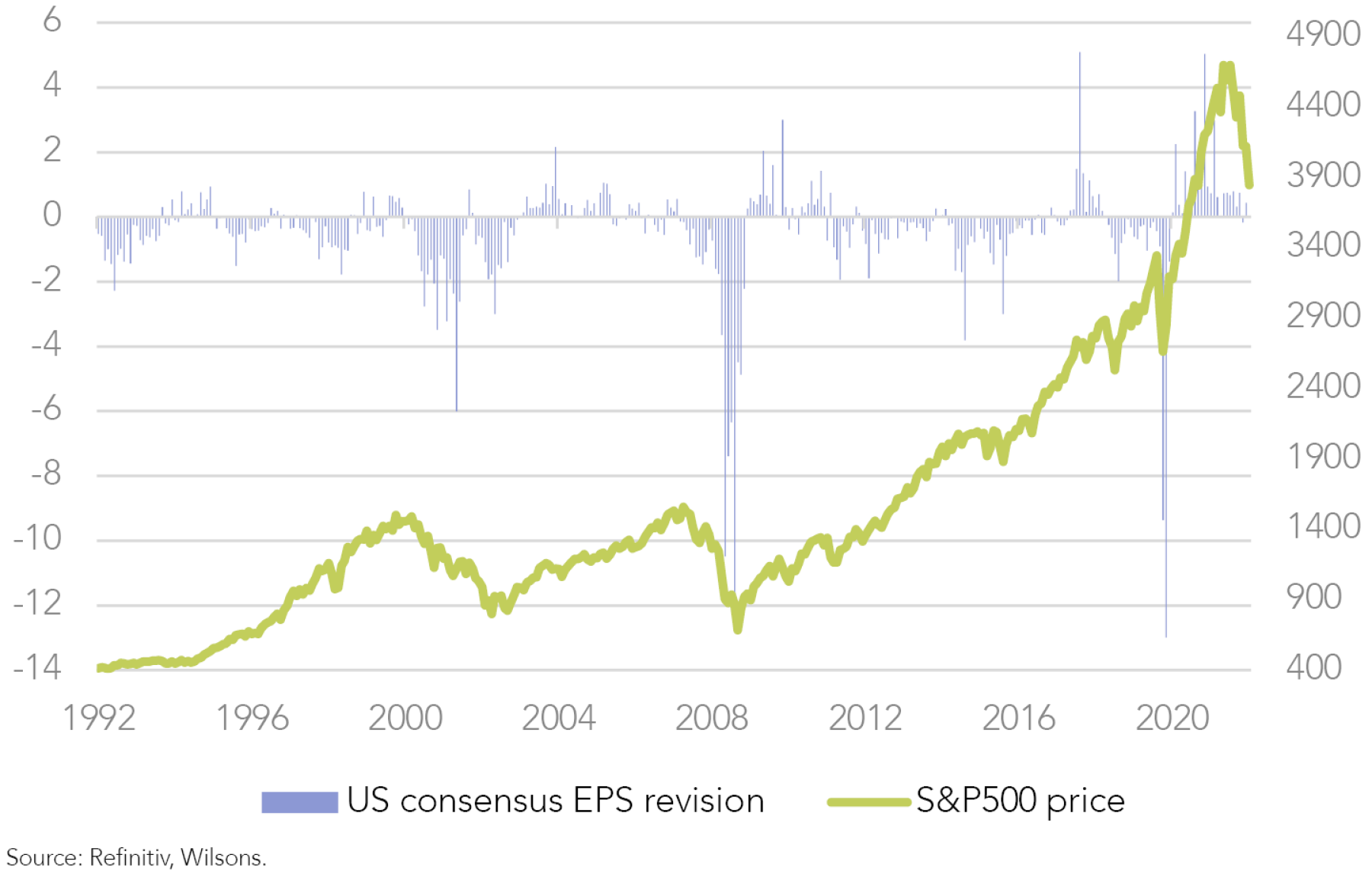
Bonds and equities have both been under intense pressure this year as higher-than-expected inflation has led to increasingly hawkish central bank interest rate guidance.
This has pressured both bond and equity valuations. More recently, the market narrative has shifted to focus more on economic slowdown (recession) risks. The inflation story is still very much bubbling away in the background, and central banks are still full of hawkish rhetoric, but recent market price action is telling a somewhat different story to what central banks are (belatedly) emphasising.
After the sharpest sell-off on record, bonds have rallied, with the US 10-year yield easing back from a mid-June peak of 3.4% to a current level of 2.9% (July 7). Australian yields have seen an even larger retracement, easing back from a peak of 4.2% to 3.4%. While this is perhaps based on a market view that inflation is peaking, it also reflects a view that growth is set to slow significantly. This view is also seen in the cash futures market, where expectations of peak policy rates for the Reserve Bank of Australia (RBA) and the Fed have been wound back in recent weeks.
So, while the inflation outlook is still very much in investor (and particularly central bank) thinking, the growth outlook is now arguably seen as the most significant source of risk.
This has been emphasised in the past week or so by the significant acceleration in downward momentum for the majority of commodity prices, most notably the oil price.
This is something of a double-edged sword in that a rapid weakening in commodity markets is signalling that a significant economic slowdown is likely unfolding. Still, it also relieves some of the inflationary/cost of living pressures that have been plaguing the global economy this year.
Growth Slide, Inflation Slide, or a Bit of Both?
So, we are at an interesting juncture. The more bearish interpretation is that the global economy is set to slide into recession with a stubbornly high inflation backdrop (stagflation). The optimistic interpretation is that growth is slowing but not collapsing, while the stubborn inflation pressures of the past 12 months are finally showing signs of a meaningful deceleration.
Our own view is closer to the more optimistic of these scenarios than to the stagflation bear case. We still see the probability of the US and Australian economies avoiding a genuine recession as better than 50%. At the same time, the seeds of a sizeable deceleration in inflation over the second half of this year seem to be finally falling into place.
Of course, navigating current markets remains a tricky task. If the US is indeed set to fall into recession (not our central case), history suggests that equities have probably not bottomed.
We cannot find any evidence of equities bottoming ahead of a genuine recession (as defined by the National Bureau of Economic Research). Equities tend to bottom during recessions, not before (see figure 1). The better news, firstly, is that equities bottom well before recessions are over. Secondly, while we believe a recession is a risk that needs to be considered, it still does not seem inevitable in our view (see figure 2). If the US can avoid a genuine recession and inflation eases as we expect, then the market could now be forming a bottom and the rebound could be considerable given such a dramatic pullback in the first half of the year.
Recession Period* |
US market peak versus recession start | Market low versus recession start | Peak to trough US equity fall |
Fed rate peak versus recession start | Bond yield peak versus recession start |
Months (before)/after start |
Months (before)/after start | Months (before)/after start | Months (before)/after start | ||
| Nov 73 - Mar 75 | -10 | 13 | -48 | 5 | -3 |
| Jan 80 - July 80 | 0 | 3 | -10 | 2 | 3 |
| July 81 - Nov 82 | -8 | 12 | -22 | -1 | 2 |
| July 90 - Nov 91 | -2 | 3 | -19 | -1 | -2 |
| Mar 01 - Nov 01 | -7 | 18 | -48 | -10 | -10 |
| Dec 07 - Jun 09 | -2 | 15 | -55 | -18 | -18 |
| Mar 20 - Jun 20 | 0 | 1 | -34 | -17 | -17 |
*Recessions defined by the National Bureau of Economic Research (NBER).
Source: Refinitiv, NBER.
Negotiating the Earnings Cycle
One issue the market will need to digest is the issue of earnings downgrades. Earnings estimates have remained resolutely high in the face of mounting evidence of slower economic activity. US earnings per share (EPS) growth for 2022 stands at 9% and at 10% in 2023. This has changed little in the past 3 months.


Once again, the bearish scenario is that a recession is coming, and US earnings have typically fallen 15% to 35% in recessions (see figure 4). This is why it would be unlikely the US market would be bottoming now if the US is headed for a genuine recession. Even if the US is going through a slowdown rather than a significant contraction, consensus estimates are likely to have a fair bit of downside, possibly to around zero growth in CY23.

Figure 4 shows that earnings contractions/recessions are more common than economic recessions. Markets can fall into mild earnings contractions accompanied by downward earnings revisions (figure 5) more readily than into economic recessions when earnings typically come under significant pressure. The ability to rally despite flat or mild falls in earnings is generally the case because the deterioration is priced in at the overall market level ahead of the earnings slowdown. At the same time, equities ultimately get support from lower bond yields and, often, from a shift in central bank policy. In this inflation-plagued cycle, a major central bank pivot is unlikely any time soon, but an end to the tightening cycle combined with stable to moderately lower bond yields may be enough for the equity market to regain its stride, even if we shift into a persistent earnings downgrade cycle over the next 6-12 months.
Of course, at this stock level, those companies whose earnings hold up relatively well are likely to perform above average. We have allowed for this scenario by overweighting quality defensive and quality growth stocks (and quality focused managers), which should be able to rise through a period of slower economic growth.

In summary, we continue to assess conditions in terms of the inflation, interest rates and economic/profit growth outlook. Conditions are continuing to shift quite rapidly, with growth concerns rising but rate pressures easing somewhat. We remain neutral on equities and are emphasising quality in equity portfolios. We have upweighted bonds close to neutral, given more attractive running yields and a slower economic outlook. We still hold an overweight to alternative assets (albeit somewhat reduced) as an attractive risk-adjusted position given unusually uncertain macro conditions.

Written by
David Cassidy, Head of Investment Strategy
David is one of Australia’s leading investment strategists.
About Wilsons Advisory: Wilsons Advisory is a financial advisory firm focused on delivering strategic and investment advice for people with ambition – whether they be a private investor, corporate, fund manager or global institution. Its client-first, whole of firm approach allows Wilsons Advisory to partner with clients for the long-term and provide the wide range of financial and advisory services they may require throughout their financial future. Wilsons Advisory is staff-owned and has offices across Australia.
Disclaimer: This communication has been prepared by Wilsons Advisory and Stockbroking Limited (ACN 010 529 665; AFSL 238375) and/or Wilsons Corporate Finance Limited (ACN 057 547 323; AFSL 238383) (collectively “Wilsons Advisory”). It is being supplied to you solely for your information and no action should be taken on the basis of or in reliance on this communication. To the extent that any information prepared by Wilsons Advisory contains a financial product advice, it is general advice only and has been prepared by Wilsons Advisory without reference to your objectives, financial situation or needs. You should consider the appropriateness of the advice in light of your own objectives, financial situation and needs before following or relying on the advice. You should also obtain a copy of, and consider, any relevant disclosure document before making any decision to acquire or dispose of a financial product. Wilsons Advisory's Financial Services Guide is available at wilsonsadvisory.com.au/disclosures.
All investments carry risk. Different investment strategies can carry different levels of risk, depending on the assets that make up that strategy. The value of investments and the level of returns will vary. Future returns may differ from past returns and past performance is not a reliable guide to future performance. On that basis, any advice should not be relied on to make any investment decisions without first consulting with your financial adviser. If you do not currently have an adviser, please contact us and we would be happy to connect you with a Wilsons Advisory representative.
To the extent that any specific documents or products are referred to, please also ensure that you obtain the relevant disclosure documents such as Product Disclosure Statement(s), Prospectus(es) and Investment Program(s) before considering any related investments.
Wilsons Advisory and their associates may have received and may continue to receive fees from any company or companies referred to in this communication (the “Companies”) in relation to corporate advisory, underwriting or other professional investment services. Please see relevant Wilsons Advisory disclosures at www.wilsonsadvisory.com.au/disclosures.
